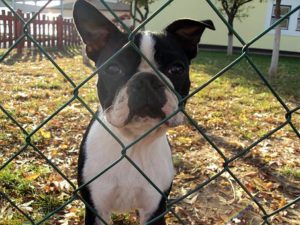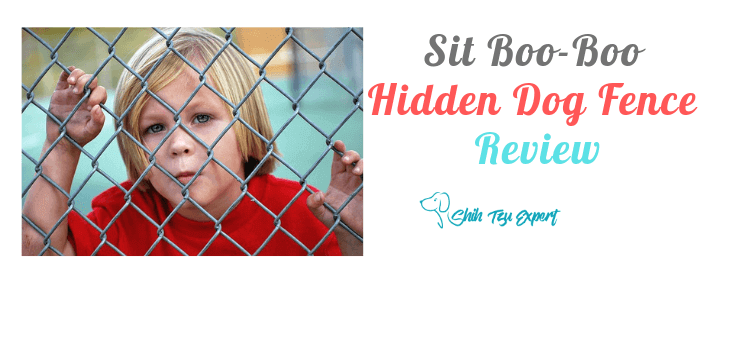So, you decided to get a wireless dog fence, did you? Crack open a cold one and do a secret handshake with yourself, friend. An invisible fence is an excellent addition to a dog’s habitat. You and your pup are emBARKing (ba dum chhh) on a fun new nature-y experience together.
As with any adventure, there are tough choices, hard work, and good times ahead of you. This article will hopefully iron a few kinks from your upcoming invisible fence ventures, making it easier for you to move full speed ahead with your plans. Carry on reading for helpful information about an excellent invisible fence!

PetSafe In-Ground Fence – Or Should We Say Fences
Alright, you got us. We said we had one fabulous in-ground fence for you to consider – but we actually have two! Someone stop us, we’ve gone rogue.
As you’ll soon see, however, these two fences have a lot in common – and the differences will actually help you decide which fence to get for your fur baby.
It’s safe and effective for most pets who weigh at least eight pounds, and the system supports an unlimited number of pets (each with their own collars, of course). The PetSafe Basic In-Ground Fence kit can surround up to a 1/3 acre with the included wire. Pet parents with larger yards can buy additional cable and enclose up to 5 acres of safe play area for their fur babies. The included collar is waterproof and gives you a tone-only option for use while training your pup, and four correction levels to set afterward.
While the Basic fence system is suitable for pets eight pounds and up, the Stubborn fence is best for dogs who weigh at least 30 pounds. It’s designed for particularly stubborn dogs and dogs who are difficult to train. Like the Basic system, the Stubborn Dog In-Ground Fence system can enclose up to a 1/3 acre with the wire in the kit and includes a waterproof collar with tone mode and four levels of correction. It can also support an unlimited number of dogs wearing collar receivers.
What’s so great about PetSafe’s In-Ground Fences?
Whether you know everything there is to know about invisible fences, or you’re just beginning your research, why not start off with the good news? There are plenty of features to love about PetSafe’s In-Ground Fences.
Pro: Anyone can use a PetSafe In-Ground Fence
Pro: PetSafe’s In-Ground Fences support innumerable dogs
Some invisible fences have a limit on the number of dogs allowed per system, or charge you for each additional dog – for example, a two-dog fence would cost more than a one-dog fence. PetSafe, however, supports an unlimited number of dogs on any of their fencing systems.
Pro: PetSafe’s In-Ground Fences are affordable
Unsurprisingly, there are pros and cons to a traditional chainlink or wooden fence, too. And one of the definite downsides to a conventional fence is cost. Compared to an invisible fence, a traditional fence can cost thousands of dollars for material and labor. PetSafe’s In-Ground Fence systems cost a fraction of that amount and can be completely installed in a matter of hours, saving you time as well as money.
Pro: A well-trained dog is a happy dog
Like some humans, dogs appreciate routines and knowing what to expect from their day. They like predictable mealtimes and bedtimes, and they want their humans home 24/7 to spoil them rotten. Dogs also want to understand how their households work: what’s expected of them, what’s allowed, and what’s against the rules. Clear boundaries give pups a better grasp of their dog-day routines. Additionally, some dogs are people-pleasers and love nothing more than learning new things to make you happy. Since you have to train your dog to use PetSafe’s In-Ground Fences, he ends up more well-trained overall – a polite member of society and a well-behaved member of his beloved family.
Pro: PetSafe’s In-Ground Fences are wired
There is more than one type of invisible fence on the market today: You can buy a wired fence or a wireless fence for your property. A wireless fence projects a circular radio boundary from a transmitter in your house to the edge of your dog’s outdoor play area. Then, as with a wired fence, the radio signal communicates with your dog’s collar to keep her inside the safe zone.
A wired invisible fence can be laid in any shape imaginable: protecting one edge of your house where your dog likes to dig, or surrounding your pool so your dog can’t get into trouble (or danger). But a wireless invisible fence can only project a circular boundary. You can’t follow the edge of your yard with a wireless fence (unless your yard is a perfect circle for some reason). You also can’t use a wireless fence to cordon off smaller areas within your property, like a pool or garden.
Are invisible fences cruel?
A prevalent concern about invisible fences is that they seem cruel to dogs. When using an invisible fence, a dog wears a collar with a large radio receiver and sizeable metal prongs that touch his skin. When he innocently walks over the invisible barrier, he’s zapped with an electric shock. Doesn’t that sound like a harsh punishment for a pup just following his doggy instincts to chase squirrels?
However, this common misconception is based on a lack of information. The collar receiver is not heavy or disruptive for your dog. She quickly gets used to it, like she got used to a regular collar when she was a puppy. The receiver is designed to be as lightweight as possible. Since an 8-pound Yorkie can wear it, there’s no need to worry if the receiver is too bulky for your 60-pound Golden Retriever. The metal prongs are not sharp or irritating – like the presence of the receiver, your dog soon grows accustomed to them. And your dog doesn’t have to wear the receiver 24/7 – you can take it off her every night to recharge it.
Additionally, your dog won’t be confused about why he’s getting shocked – he knows the fence is there, and he knows a shock means he’s breaking the rules. Once properly trained, many dogs never try to cross the invisible fence and thus never feel the shock again. Don’t worry – invisible fences are humane solutions for fencing your yard and keeping your precious pup safe.
Cons of the PetSafe In-Ground Fence
Con: You have to teach your dog how to use the fence
A chainlink or wooden fence is pretty self-explanatory. Your dog can go anywhere up to the fence, and then she has to stop (or try to dig under it). As the name suggests, however, an invisible fence is completely hidden. Your dog only sees green grass and the squirrel she wants to chase in your neighbor’s yard. Helping your pup understand the new boundary takes time. Without your assistance, she’ll repeatedly try to charge her nemesis the squirrel and grow confused and frustrated by the unexplained shocks she feels.
Con: The PetSafe In-Ground Fences don’t keep other dogs out of your yard
A traditional fence keeps strange dogs and strange people out of your yard (or at least makes them work a lot harder to get onto your property). The PetSafe In-Ground Fences keep your own dog from running wild through the streets, but any other animal can still wander in or out of your yard. Depending on your neighborhood, this may or may not be an issue for you.
Con: PetSafe’s In-Ground Fences don’t block nosy neighbors
Sometimes the old adage rings true: “Good fences make good neighbors.” A traditional chainlink or wooden fence creates a slight barrier between you and the surrounding houses. Maybe you don’t want to the neighbors to know that you stay up til 3am playing Dungeons and Dragons on the weekend. You’ve seen their skeptical faces, and you don’t need that kind of negativity in your life. Or maybe you don’t want to see your neighbor’s plumber butt as he putters with the old Chevy that’s been in his driveway for as long as Fluffy has been alive. Good point – we don’t want to see it, either. An invisible fence, however, won’t give you any privacy. After you buy one of PetSafe’s In-Ground Fences, Frank’s posterior is still visible from your house.

Con: You can’t travel with PetSafe’s In-Ground Fences
After installation, your PetSafe In-Ground Fence is buried in the ground. This keeps your lawn in such pristine condition that your neighbors will get whiplash ogling it as they drive by. (Results not guaranteed.) However, this also means that you can’t take a PetSafe In-Ground Fence on vacation with you. It stays buried in the dirt with the earthworms while you and Fluffy jetski across the Caribbean waves (as you both do regularly, right?).
How To Install Your PetSafe In-Ground Fence
Firstly, decide on your layout. It’s helpful to sketch your property on a piece of paper and choose which sections you want to enclose with your fence – your front yard, back yard, pool, garden, etc. If your property is extensive, buy additional wire.
Next, walk around your property and physically lay the wire where you want to install it. Don’t forget your pool or garden if you decided to fence those off! When you’re placing the wire, don’t plan to install it in the ground at sharp angles (e.g., a 90-degree turn) – use a wider, gentler angle to ensure the wire can function correctly.
At the point where your wires come together and then run towards your transmitter, twist the wires together. Your dog can cross the twisted section of wires without receiving a shock. Plug your transmitter into a standard outlet in a dry location. Then connect your invisible fence wires to your transmitter (the area to join them is conveniently labeled). Set your dog’s receiver collar to tone mode and walk around the wire with the collar in hand to ensure it’s working correctly.
Holding the receiver collar again, set flags around the boundary of your invisible fence. This also lets you ensure that the fence is functioning correctly.
Lastly, configure your transmitter. You can choose the boundary zone and shock level for your dog’s collar. For now, set the collar to tone-only for training. The “boundary zone” is the area on either side of your invisible fence where your dog will receive a warning tone or shock. Using the transmitter, you can adjust the boundary zone from a few inches to multiple feet. PetSafe has helpful YouTube videos available online to help you with installation if you have further questions.
Congratulations, your fence is installed! Now it’s time to train your dog.
How To Train Your Dog
Equally as important as installing the fence is teaching your dog about the fence. Be patient with your pup as she learns the ropes – she’ll understand eventually!
Training Day 1
On Day 1 of training, set the receiver collar to tone-only correction. Start off with play time, then lead your pet to the edge of the boundary area, which is marked by your flags. Let your pup hear the warning sound from the collar, then lead her back away from the invisible fence. Immediately praise your pup and give her a treat. Repeat this in the same spot over and over again, until your pup starts to resist approaching the flags. Spend only 10-15 minutes each day teaching your dog about the new fence, so she doesn’t get too tired or overwhelmed to learn.
Training Days 2-4
For the next few days of training, set the collar to level 2 correction. Some pets won’t even register a level-2 shock, but it’s a decent starting place for training. With the collar set this way, your dog gets the warning tone as well as the shock. If your pup doesn’t react at all to level 2, increase the setting to level 3, and try again. You’ll know your dog is feeling the collar if he perks up his ears, looks around, looks at the ground, or gives another indication that he’s trying to understand what happened. Again, don’t worry – your dog isn’t in pain! The collar merely got his attention, like it’s supposed to. Keep training him, and soon he’ll understand how the system works.
Lead your pup up to the boundary again, then let him hear the warning tone and feel the shock. Then lead him away, praise him, and give him a treat. If your dog seems stressed or frustrated, take a break for some play time and belly rubs. Afterward, continue the process of leading your pet to the flags, letting him hear and feel the collar’s reaction, and leading him away for more praise and treats.
Continue this over the next few days until your dog resists approaching the flags. Don’t forget to be patient and keep training sessions short and fun!
Training Days 5-8
By now, your dog probably has a grasp of the yard’s boundaries. She knows where she can play happily and safely, and where the flags are to keep her inside the fence line. But sometimes the events (or animals and people) just outside the invisible fence are powerful temptations for your pet. Sure, right now, she enjoys getting treats for staying on this side of the invisible fence. But what if your neighbor’s cat prowls past on the other side?
Approach the invisible fence with your dog on his leash, wearing the receiver collar. This time, show your dog one of his favorite toys and then throw it over the invisible fence. If your dog resists the urge to cross the boundary, quickly shower him with praise and treats. After a while, try showing him a treat and then tossing the treat away from him, past the flags that he’s not supposed to cross. Again, if he doesn’t bolt across the fence line, lavish him with rewards. Continue this process around the entire boundary of your invisible fence.
If your dog can’t withstand the temptation, don’t give up! Practice with less attractive items and gradually work up to using his favorite toys and snacks as “bait” on the other side of the fence. Be patient and consistent, and your dog will eventually learn to respect the fence line.
Training Days 9-15
If your dog is consistently ignoring temptations on the other side of the fence, you’re ready to continue training without keeping her on a leash. Take your dog outside without her leash on, but don’t throw any tempting items across the fence just yet. Play with your dog and give her plenty of attention, so she’s having fun.
After a few days, you can check to ensure that your dog still respects the invisible fence line. Toss a toy or treat over the flags away from your pup, or walk across the fence line away from her. If she doesn’t cross the border, reward her! She’s doing great!
If your dog bolts over the fence line, retrieve him, take the collar off, and bring him back inside the invisible fence. You might need to repeat some of the previous training. Just keep practicing and encouraging your pup when he does a great job.
After about two weeks, you can start to remove the flags if your dog is consistently staying within the invisible fence. Remove the flags gradually – every other flag for four days, at which point all the flags are gone. (You might want to save the flags in case you need to train a new pet to use the fence.)
Additional Tips For Using The Fence
Take the collar off at least once a day to charge it and give your dog a well-deserved break while she’s napping inside or snoring through the night.


![PetSafe Wireless Dog Fence [Review’s and Important Information] PetSafe Wireless Dog Fence [Review’s and Important Information]](https://shihtzuexpert.com/wp-content/uploads/2020/02/1-5.jpg)
![10 Best Dog Crates for Separation Anxiety [High anxiety dog crates 2019 Reviews] 10 Best Dog Crates for Separation Anxiety [High anxiety dog crates 2019 Reviews]](https://shihtzuexpert.com/wp-content/uploads/2019/05/5-3.jpg)

![Custom shape wireless dog fence [Electric Fencing and Electric Barrier Systems] Custom shape wireless dog fence [Electric Fencing and Electric Barrier Systems]](https://shihtzuexpert.com/wp-content/uploads/2019/07/Custom-Shape-Wireless-Dog-Fence-Review.png)



